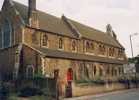For this church:    |
| ||||||||||||||||||||||||||||||||||||||||
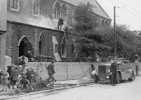 The
organ fire The
organ fire16th August 1946 (Photo: Nottingham Journal) |
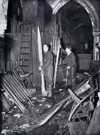 Dismantling
the old Dismantling
the oldorgan after the fire (Photo: Nottingham Journal) |
The original instrument gave excellent service, and continued in use for forty nine years and nine months, until 16th August 1946 when it was destroyed by fire. The alarm was raised by a small boy, who, seeing smoke coming from the church roof ran into a local shop and raised the alarm. The cause of the fire was not discovered, but it was thought that an electrical fault was the most likely explanation.
For two years musical accompaniment was provided by the use of a Broadwood Boudoir Grand Piano.
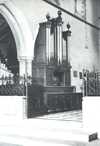 The
new organ The
new organin place in 1948 (Photo: Roger Yates) |
Whilst the original instrument was well loved by the eight organists who played it over its lifetime, the church was extremely fortunate in being able to purchase a replacement which is today regarded as ‘probably one of the most important organs within the diocese’. It is not recorded how the church located the organ, or its purchase price; possibly it was advertised in a church or organ publication. What is known is the organ’s history and the details of its rebuilding in St Catharine’s.
The organ was removed from the Great Hall of Tockington Manor near Bristol in 1948, when the Manor was sold by the son of Colonel Henry Thomas Salmon, who had owned the house since 1872. As the major part of the organ work has been dated to early 1870, and the case to the 1760s, it can be assumed that the organ was probably installed by Colonel Salmon soon after he purchased the property.
The case of the organ is much older, being a magnificent example of the work of organ builder Richard Seede of Bristol. Produced about 1760, it is one of only three examples of Seede’s work know to have survived. The display pipes with bay leaf mouths are also of English workmanship circa 1760. The mahogany case inlaid with a large oval of kingwood on the console cover is in excellent condition with only small sections of the cross-banded border missing. The thickness of the veneer, nearly one eighth of an inch, can be seen at these points and supports the reported age of the organ case.
The organ when housed in Tockington Manor is known to have been rebuilt by August F.H.Gern as a salon organ in the early 1870s. Gern (1837-1903) was a native of Berlin, and from 1860 to 1866 served as erecting foreman in France for Aristide Cavaille-Coll. It is almost certain that the organ contains a considerable amount of pipe-work made in Paris, as Gern was not manufacturing his own until after 1872.
The Tockington Manor Organ specification was:
| Great Organ 56 notes CC to G | Swell Organ 56 Notes CC to G | Pedal 29 Notes | Couplers: |
| Open Diapason 8ft Lieblich Gedackt 8ft Vox Angelica 8ft Geigan Principal 4ft Lieblich Flote 4ft Octavin 2ft | Lieblich Bourdon 16ft Flute Harmonique 8 ft Viole de Gambe 8ft Voix Celestes (Ten.C) 8ft Gemshorn 4ft Basson Dessus 16ft Basson Basse 16 ft Trompette 8ft | Bourdon 16ft Viola 8ft | Great-Swell Great-Pedal Swell-Pedal |
| Action: | Tracker manuals - Pneumatic pedals | ||
| Wind pressure: | 2.625 inches throughout. hand blowing | ||
The organ was rebuilt at St Catharine’s by Roger Yates in 1948. The work was done under the guidance of Ralph Downes, later the designer and curator of the organ in the Royal Festival Hall, London. Tonal modifications were designed to increase the resources of the organ while preserving completely its original characteristics.
Specification of the new organ:
| Great Organ 56 notes CC to G | Swell Organ 56 Notes CC to G | Pedal 29 Notes CCC to F | Couplers |
| Lieblich Bourdon 16ft Open Diapason 8ft Lieblich Gedackt 8ft Vox Angelica 8ft Geigan Principal 4ft Lieblich Flote 4ft Doublette 2ft | Flute Harmonique 8ft Viole de Gambe 8ft Voix Celestes 8ft Gemshorn 4ft Fourniture 2 to 5 ranks Basson 16ft Trompette 8ft | Bourdon 16ft Lieblich Bordun 16ft Quint 10.67ft Viola 8ft Quintade 4ft Basson 16ft | Great to Pedal Swell to Pedal Swell to Great Swell octave |
| Accessories: | Two combination pedals to Great
Organ Two combination pedals to Swell Organ Balanced Swell pedals | ||
| Action: | Tracker and Pneumatic to manuals | ||
| Wind pressures: | Pipework 2 5/8 inches Pressure action 5 inches | ||
All metal pipework including reeds, with the exception of the lowest octaves of the Open Diapason, Flute Harmonique and the Viola de Gambe which are of zinc, are of fine spotted metal. The lowest octave of the Quintade is of plain metal
The original organ had been installed in the first arch of the north wall of the cancel. The Gern organ was re-sited into the second arch moving it nearer to the altar, with its working extended into the choir vestry.
The organ was dedicated on 29th September 1948 by Rev Canon R.F.Wilkinson. The dedication service is recorded in the publication from which most of the above information has been extracted. After the dedication Ralph Downes gave a recital on the new organ. The pieces played were;
Tocata and Fugue in D minor J.S.Bach
Variations on My young life hath an end J.P.Sweelinck
Menuet-Scherzo Joseph Jongen
Two pieces for mechanical organ W.A. Mozart
Impromtu Louis Vierne
Eclogue Bernard Wagenaar
Piece Heroique Cesar Franke
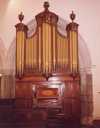 Recent
picture of the organ case, Recent
picture of the organ case,before it was moved to Shelford |
With the redundancy of St Catharine’s, the organ has now been moved to the church of Shelford St Peter.


